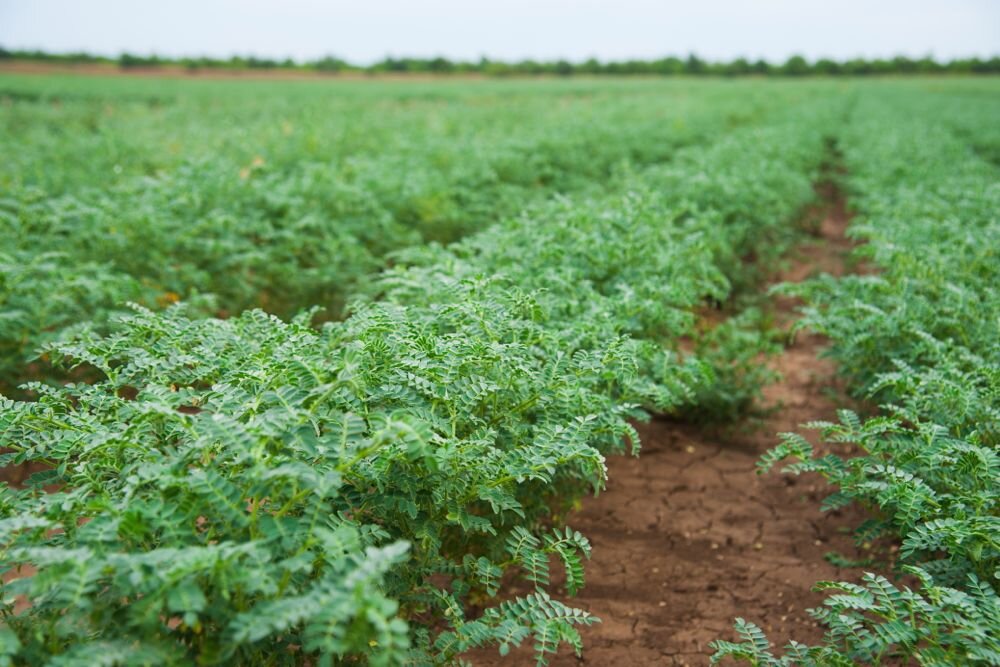Chickpeas: Cicer arietinum
The Chickpea
Cicer arietinum
Fabaceae
The chickpea (also called garbanzo or gram) was one of the first grain legumes to be domesticated. It is important in Indian, Mediterranean and Middle Eastern cuisine, but also, according to archeological evidence, was important to the Paleolithic people of the Middle East. The chickpea is a key ingredient in hummus and chana masala, and it can be ground into a flour to make falafel. It is also used in salads, soups and stews, curry and other meal products like channa. India and Turkey are the largest producers of the farmed legume. The chickpea is also used as an animal feed because of its high protein content.
This crop most probably originated in an area of present-day south-eastern Turkey and adjoining Syria. There are 44 species of Cicer, distributed mostly in the Middle East and Asia. Three wild annual species are closely related to the chickpea: C. bijugum, C. echinospermum and C. reticulatum. Cicer reticulatum can be considered as a possible progenitor, or perhaps had a common ancestor with the chickpea.
The Latin word, cicer--whence the famous orator Cicero got his name, since his family grew chickpeas--led to pois chiche in modern French, which we lifted from across the English Channel and changed to chich-pease—with the modern spelling as chickpeas. The other common name garbanzo comes from the Spanish term for chickpea, a compound of “garau” meaning “seed,” and “antzu” meaning “dry.
Worldwide, 12.1 million tons of chickpeas are cultivated each year. India accounts for 64% of chickpea production as of 2016, producing 7.1 million tons of chickpeas that year. Myanmar produces 0.6 tons, Pakistan and Turkey each produce half a ton, and Russia and Ethiopia produce 0.4 and 0.3 tons, respectively.
This crop plays an important role in agricultural systems today ranking third in the world among pulses in production, behind dry bean, and field pea. Chickpeas currently supply over 20% of the world with protein, but crops are under threat from climate change coupled with a lack of genetic diversity. Chickpeas were bred so that the seed remains with the plant, but this has lead to less diverse genetics. A lack of genetic diversity has left chickpeas susceptible to any environmental change.
Two seed types are recognized: the large-seeded kabuli type, characterized by its beige-colored seed coat and ram's head shape, and the desi type, with its smaller size and dark-colored irregularly shaped seeds. Within these two types there are many varieties. Kabuli varieties are preferred for consumption as whole seeds, whereas desi types, though eaten whole in much of India, are more typically processed into flour. Immature green pods and young tender leaves are also cooked and eaten as vegetables, especially in India where plants are more commonly growing and available to eat that way.
The chickpea is grown worldwide and is best adapted to cooler, dry climates. So in Arizona it is a cool season annual crop—it is perennial elsewhere but cannot withstand our summer. Like all legumes, chickpeas are best sown directly rather than purchased as a starter plant. Plant the “peas” in the fall. The plants will grow to about 2’ tall and wide. They will flower in late winter or spring with pea-like flowers that are usually white and/or purple, and will produce pods that contain 2-3 “peas”, usually ready to harvest in late spring or early summer. They are legumes, so they don’t require a lot of fertilization. Just a decent amount of organic compost in the soil will suffice.
In most ordinary grocery stores, you will find the typical beige, kabuli type of chickpea popular with European cuisine, canned or dried. You might find it as already-processed hummus. In the Asian markets you will find all the other types of chickpeas—especially the desi types which will be smaller, and have the most diversity of colors (black, green, purple, etc), and you may also find the chickpea dahl, or split dried chickpea. Though we mostly think of dahl as a dish, on bean packaging the word refers to the fact that the “pea” has been split. In fact the word dahl is derived from Sanskrit meaning “split”. Chickpeas are also made into a flour used for many, many dishes, and recently has become a gluten-free alternative for baked goods, though the most common uses for chickpea flour are not for baked goods.
At our home we mostly use chickpeas for curried dishes very much as done in India, using lots of spices and vegetables. We definitely make hummus occasionally too. Because I’m a botanist, every time I see a different type of chickpea, I buy some, just to play around with them. We haven’t cooked too much with chickpea flour but I intend on exploring that ingredient a lot more very soon. To make chickpea flour at home, roast the chickpeas in a 400°F oven for 15 to 20 minutes, or until the chickpeas start to give off a nutty aroma and are lightly browned. You can then use a coffee grinder or spice blender and process until the consistency is right. Run through a sieve to remove any large particles. You don’t NEED to roast the chickpeas beforehand, that is just an option that adds more flavor.
I have found the most diversity of chickpea products at the Asian markets like Grant-Stone Market and Lee Lee International Supermarket. I am not sure how viable the dried chickpeas are for growing—it’s worth trying especially for the desi types which are harder to find. Baker Creek Heirloom Seeds offers the black kabouli garbanzo bean. Terroir Seeds has Kala Chana Garbanzo. You can also try Etsy where many cool varieties pop up here and there.




